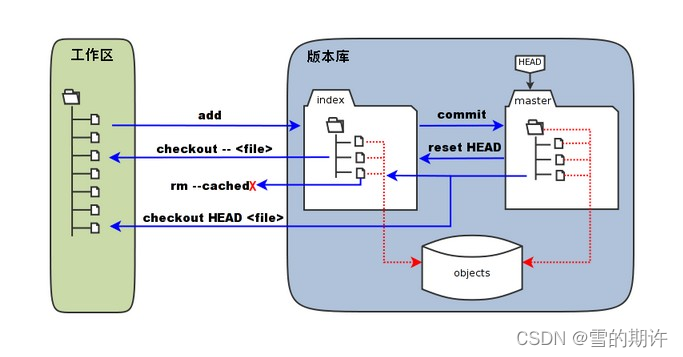?基本原理

- 工作区:自己电脑上看到的项目,也就是自己写的代码。
- 暂存区:介于工作区和版本库之间的一个缓冲区(保存在
.git/index),用户改过的代码必须先执行git add添加到暂存区,然后才能执行git commit将代码更改同步到版本库分支。另外,git commit -a可以一次性将代码的更改和删除添加到缓存区并同步到版本库,但新建的文件不会添加到缓存区,还是要用git add添加。 - 版本库:工作区有一个隐藏目录 .git,这个不算工作区,而是 Git 的版本库。
- HEAD:指向 master 分支的一个"游标"。图示的命令中出现 HEAD 的地方可以用 master 来替换。
假设项目结构为
|--MyProject/
|--.git/
|--text.txt
|--readme.md
🍅常用命令
分支管理(初始默认master分支)
git branch [branchname] # 创建分支
git checkout [branchname] # 切换分支
git checkout -b [branchname] # 创建并切换到新分支
git add 从工作区向暂存区添加更改
git add [file1] [file2] # 添加一个或多个文件到暂存区
git add [dir] # 添加指定目录到暂存区,包括子目录
git add . # 向暂存区添加文件:新文件(new)、修改(modified)文件,不含删除(deleted)文件
git add -u # 向暂存区添加文件:修改(modified)、删除(deleted)文件,不含新文件(new)
git add -A # -A是--all的缩写;向暂存区添加文件:修改(modified)、删除(deleted)、新文件(new)
git checkout
git checkout <filename> # 将暂存区指定文件覆盖本地
git checkout . # 将暂存区的所有文件覆盖本地,不影响新建但没添加到暂存区的文件
# checkout 指定分支名或使用-f时,将直接从版本库拉取代码覆盖暂存区和本地
git checkout master # 将HEAD游标切换到master分支,本地和暂存区都将被覆盖为master
git checkout master <filename> # 从版本库拉取文件覆盖本地
git checkout -f # 从版本库拉取所有代码强制覆盖暂存区和本地,不影响新建但没添加到暂存区的文件
从暂存区提交更改到版本库
git commit -m "本次提交说明信息"
温馨提示
当不确定某个命令的使用方法时,可以用-h查看说明,例如git add -h将看到git add的用法如下
root@XD-PC:~# git add -h
usage: git add [<options>] [--] <pathspec>...
-n, --dry-run dry run
-v, --verbose be verbose
-i, --interactive interactive picking
-p, --patch select hunks interactively
-e, --edit edit current diff and apply
-f, --force allow adding otherwise ignored files
-u, --update update tracked files
--renormalize renormalize EOL of tracked files (implies -u)
-N, --intent-to-add record only the fact that the path will be added later
-A, --all add changes from all tracked and untracked files
--ignore-removal ignore paths removed in the working tree (same as --no-all)
--refresh don't add, only refresh the index
--ignore-errors just skip files which cannot be added because of errors
--ignore-missing check if - even missing - files are ignored in dry run
--chmod (+|-)x override the executable bit of the listed files
--pathspec-from-file <file>
read pathspec from file
--pathspec-file-nul with --pathspec-from-file, pathspec elements are separated with NUL character
🍉常用操作
强制覆盖本地代码
git fetch --all # 拉取远程代码,但不合并到本地版本库分支
git reset --hard origin/master # 将远程代码覆盖本地、暂存区、本地版本库分支
